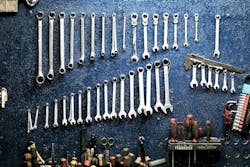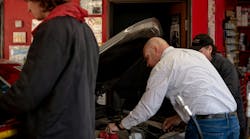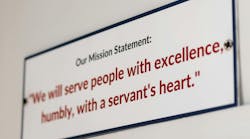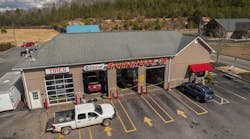With other businesses taking a bite out of profits by using oil changes as loss leaders, it’s almost harder than ever before to stand out in the fast oil change industry. The chances of shops being able to only offer oil changes and still be successful are becoming marginalized.
Adding select repairs and add-on services is already a popular way to supplement revenue, but some operators have found great success by taking this concept to the next level. They’ve maximized business and combined full service repair shops with traditional fast lubes.
This model works well because it allows the lube technicians to inspect the car for other things during the oil change. If they find something needing repair, they can take the opportunity to educate the customer, tell them about repair services offered and immediately pull the car into a repair bay to be fixed.
When the quick lube begins feeding the repair shop, a $45 oil change can turn into hundreds of dollars worth of repairs the customer would have paid someone else to do. If you don’t want to send your customers somewhere else for repairs, and you want to maximize your profit potential, consider this model.
Guard Your Bread-and-Butter
For a business in the front/business in the back model to succeed, it’s crucial to protect quick lube bay times.
Scott Morrison, owner of 14 City Garage locations in Dallas, Texas, believes in the power of the fast oil change so much he’s adding fast lube bays to his existing repair shops to pull in more customers.
“Customers still want a fast lube,” Morrison said. “The oil change is one of the few regular maintenance items customers still believe in but their time is precious. They want it done right, and they want it done fast.”
Don’t jeopardize the oil change business. It’s the service that’s gotten you to where you are today. Only add on to your service menu if you can do so without clogging your oil change bays. If you add the functions of a repair shop but fail to move cars through your oil change, this model won’t work.
Make Room
Nothing is worse than adding chaos on top of chaos. If you plan on offering more services, make sure you have enough space to provide quick lube and repair services without interfering with the “quick” part of your fast lube or the quality of your repairs.
“To successfully operate, you need the right facility. I’ve got three bays in my front building, two of them are quick lube bays and the third is where we do services like changing out headlight bulbs,” said Dave Haney, owner of Oil & Lube Express in Magnolia, Arkansas. “Directly behind my first building is another shop that looks exactly like it. It also has three bays; one has a four-post lift in it and the others have two-post lifts. We can drive cars out of bay No. 1 in the front building and drive right into bay No. 1 in the back building. I also bought the lot next door for future expansion.”
If your oil change funnels into your repair shop like Haney’s does, great, but they don’t have to be positioned directly in front or behind one another for this model to work. Just make sure the areas where you plan on doing oil change and repairs have enough room to effectively service customers without interfering with one another. You’ll want the two spaces to be close enough for convenience without being on top of each other.
Bev Cavinder is expanding her shop, Oil-N-Go in Valparaiso, Indiana, to include a separate bay at the back of her property because she’s running out of room.
“We’re trying to be more of a one-stop car care center,” Cavinder said. “I have lots of mechanically inclined employees, and it’s a shame to have to send our customers anywhere else. We’ve got a great business, we just need more room.”
If you only have one building but lots of bays, it is possible to effectively run a business this way. However, make sure it’s extremely clear what services will be performed, where they’ll be done and stick to it.
Express Lube in San Antonio, Texas has 29 stores. Seven stores do minor repairs in addition to oil changes and they operate under the signage Express Lube Plus. Six stores will fix anything from alignment issues to transmissions and engine repair. They’re called Express Lube Plus Automotive. Three of the Plus Automotive stores have stand-alone automotive shops; the other 13 operate in eight-bay buildings with four designated lube bays and four mechanic bays.
“It’s important not to jeopardize the oil change business you already have, but if you can keep the two services from interfering, the potential for higher car volumes overall is definitely there,” said Jason Smith, vice president of operations for Express Lube. “We do about 20,000 oil changes a month. The average repair shop doesn’t have that kind of customer frequency. If you can make your fast lube a one-stop-shop for customers, it will keep them out of your competitors bays and returning to yours.”
Hire Smart
Business owners agree hiring the right people for the right positions is important to the success of any business. Sure you’ll need technicians and mechanics with automotive knowledge, but take the time to find candidates who have the right skills and the right attitudes. You’ll save yourself from lots of unnecessary headaches!
“Have good people you can depend on. If they have experience, that’s great. But, what you should be looking for is the right attitude,” Cavinder said. “When I hire, I go with my gut. I don’t necessarily look for the ‘car guy.’ I look for people who will serve the customer well and know how to work on a team. Both my managers didn’t know about the oil change business when I hired them. One has been with me for eight years now, and the other has been with me for 19 years.”
If you’re adding on a repair shop, chances are you’ll have to hire the mechanics and maybe some support staff to operate it.
“In our Express Lube Plus Automotive stores we have a store manager, two assistant managers, two to three mechanics and ASE certified technicians,” Smith said.
Of course the amount of employees you’ll need will vary depending on the size of your shop, services you offer and goals such as speed, car volume and profit margin.
“We run eight-bay repair shops. We’re open six days a week for 12 hours Monday-Friday and 10 hours on Saturday,” Morrison said. “We staff those repair shops with four mechanics, a service writer and a store manager who also works as a second service writer. We give each mechanic two bays, one to work in and one to work out of. That way you can be working on a car while your waiting on parts for another.”
Haney prides himself on having reliable, trustworthy mechanics in his repair shop.
“I have two mechanics in my repair shop. They have a reputation of their own now, so I have people come to us for mechanic work who don’t get their oil changed,” Haney said.
Keep good employees by offering competitive incentives. Haney keeps things simple by paying his mechanics an hourly rate no matter how busy or slow the shop is.
“I pay my mechanics different [than most repair shops]. When they clock in, whether we’re real busy or real slow, they’re still making money. My mechanics choose from the hours I’m open and make their own schedules. They’re usually here from open to close, six days a week. It works well for me because I don’t want to keep up with individual jobs, times and bill rates. If it’s too complicated, I don’t mess with it. I try to keep things easy and simple,” Haney said.
Service and Invest Wisely
Depending on what you already have, equipment can initially require a significant investment.
Since adding repair capabilities can be a significant expense, strategically deciding what services you will offer is key to making money. When you’re deciding what to offer, carefully consider each service by asking yourself, can we effectively and efficiently perform this service? Do we have the manpower and the training to do it right? Do we have the space? And finally, what equipment does it require?
After you’ve answered those questions with as much transparency as possible, decide on how you’ll want to roll out each service. Do you want to start offering everything at once or do you want to gradually add on services? What can you afford to do?
“I do tire shop, mechanic work and quick lube work. I only do oil changes and services associated with them in my quick lube bays. Everything else goes to the back. In the bays out back, we offer everything but radios, mufflers and transmissions,” Haney said. “I can’t describe how well this set up works for us. Say a Ford pulls into one of my quick lube bays and my technician notices his ball joints and his tires are wearing on the inside, we can take the customer around and tell him exactly what is going on, what he’s going to need and what it’s going to cost. It’s an investment, no doubt about it. Like with any investment, you’re probably not going to get an immediate return. If you’re just getting into this model start with tires, alignments, brakes, shocks, struts and ball joints. Generally, stuff having to do with the under carriage is a good place to start.”
Each service should have a purpose. The oil change may lead you to look at the tires; the tires may get the car into your repair bays. Getting the car up on a lift allows you to find other things needing repair.
“You’re not going to make a killing off of tires, but when you start getting underneath the car, you’ll discover more. The opportunity for discovery is priceless,” Haney said.
The possibilities are endless, and so are the potential profits. This model is good, old-fashioned business strategy.
“We do more than 20,000 oil changes a month,” Smith said. “Those customers have to go to someone for their automotive repair needs too. Giving our customers a one-stop-shop to bring their cars keeps them out of our competitors bays and in ours.”
No matter what services you add, POS system you use or what your car counts numbers suggest, the most important thing to remember is never sell your customer something they don’t need. Instead, educate them on what you’re looking for, communicate what you find and service their cars like you would your own. As a result, you’ll establish a relationship with the customer that’s built on trust, education and loyalty. If you do, your shop will stand out and customers will come back no matter if you’ve got a party going on in the front or back.





